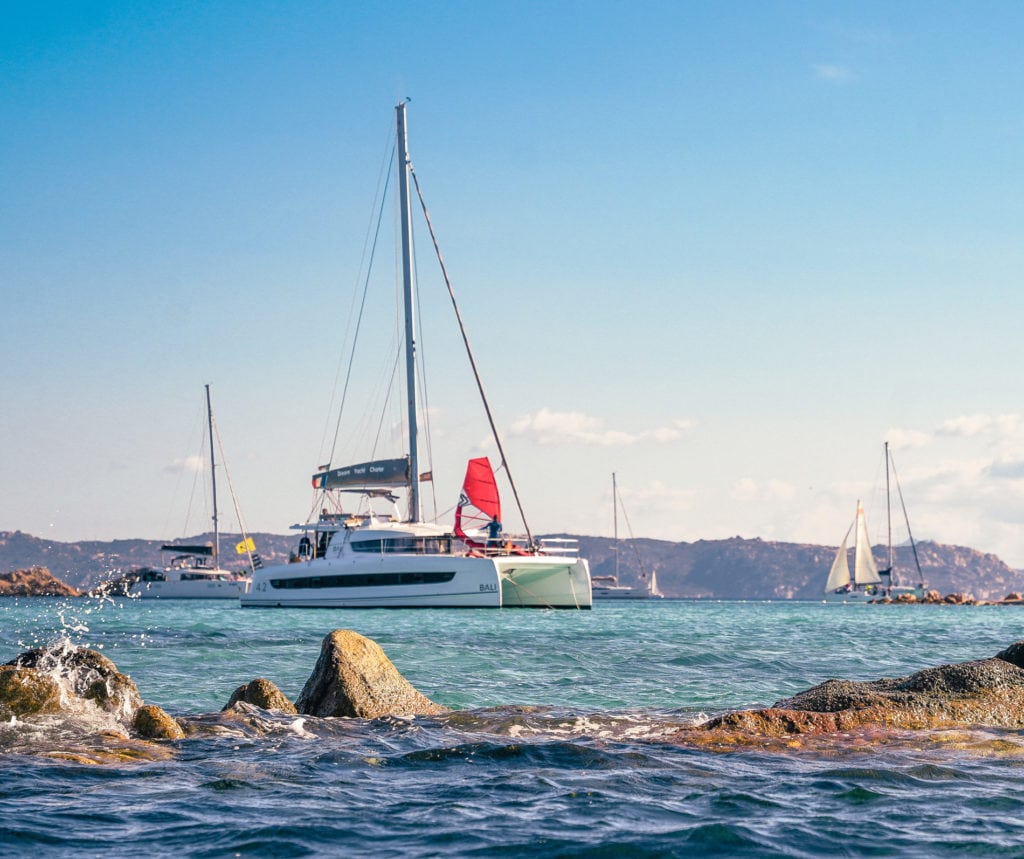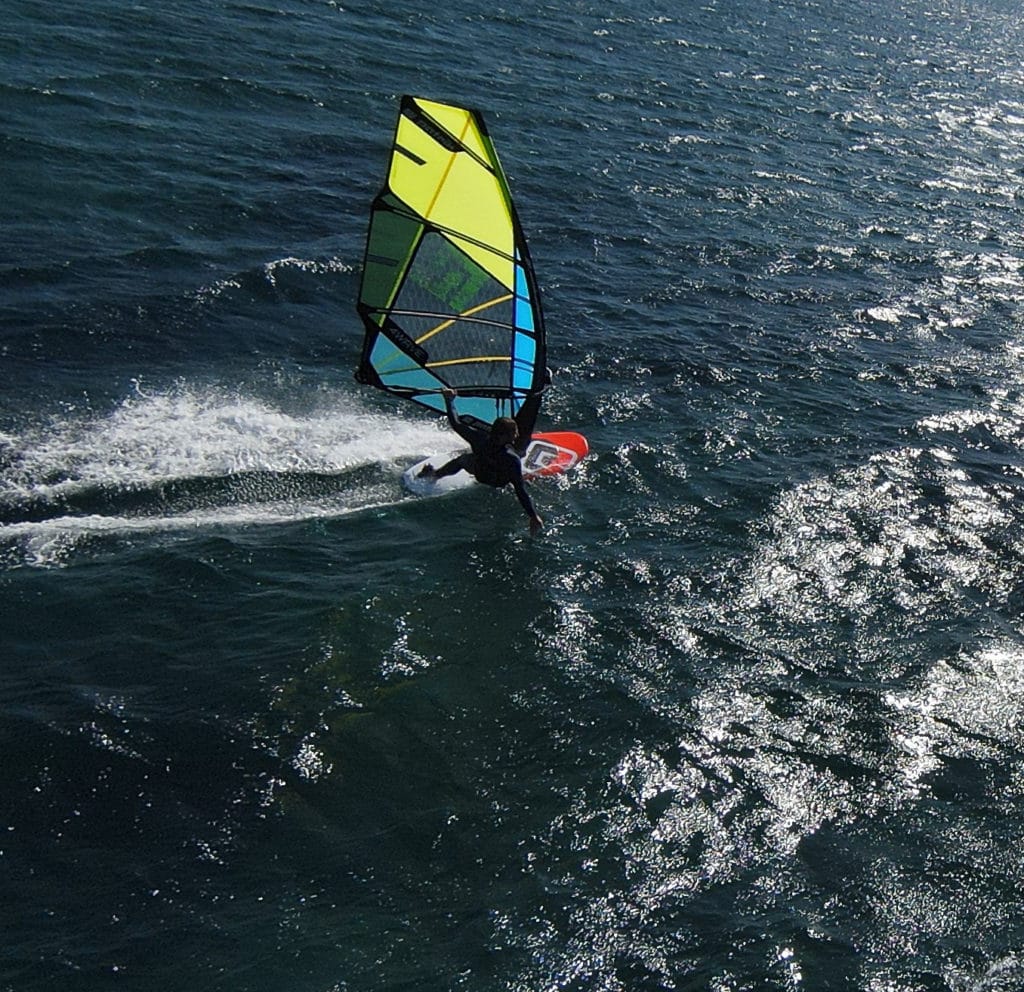Setting off on an adventure on a big boat – what a joy! But once you’ve dropped anchor in a sumptuous anchorage, the anemometer goes into overdrive. It’s frustrating not to have your board, kite or wing at hand. It’s possible to combine the pleasures of pleasure with the joys of sport!
Text: Quentin Mayerat | Photos: Sebastien Aubord & Louis Taurel
We headed for northern Sardinia, where we tested the 50% cruising, 50% gliding concept. A tempting program, but beware: choice of equipment, selection of cruising area and good logistics are key to successful sessions. Our playground stretches from Olbia to Bonifacio, via the Maddalena archipelago. The famous Bouches de Bonifacio, which form the strait between Corsica and Sardinia, have the advantage of offering steady winds almost all year round. The landscape, punctuated by picturesque islands and turquoise waters, has nothing to envy of the seas of paradise, and we intend to make the most of every square centimeter of the water on our boards, windfoils and wings!

Getting ready
A true floating loft, the cruising catamaran is the ideal support for ample storage and rigging space. The catamaran’s forward peaks can accommodate a good deal of rigging, while boards can easily be stored strapped along the side decks, on the roof or on the trampoline.

The choice of equipment must also be adapted to the weather and the sailing area. Transporting your equipment is such a hassle that it would be a shame not to take advantage of it. In our case, the forecasted conditions are light, so foils will be on board. In the pack we have an MB Boards Basilik 92L, a real chameleon. It can be sailed in fin
windfoil and wingfoil configurations. Three supports in one, an ideal compromise on a boat where space is at a premium. To complete the set-up, we opt for a Taaroa Freestyle HR foil. High-performance and rigid, it allows you to switch from wing to windfoil simply by changing the length of the fuselage: 85 cm for the wind and 65 cm for the wing. In comparison, the freeride windsurfing gear we take on board is much heavier, bulkier and less versatile!
Navigate
Departing from Olbia, on Sardinia’s northeast coast, we’re offered a veritable island slalom through a myriad of islands. However, to find the ideal drop-off point that opens the way to convenient departures for windsurfing or wing sailing, it’s necessary to study the route in advance, as well as the relief, wind direction and swell. For example, it’s a good idea to opt for protected anchorages at the end of a bay, close to a point, so you can easily get away from the wind.

Spotlights
As we cast off, we can’t wait to wake up in heavenly anchorages and ride until we’re starving, wearing out the leather on our hands. The boat offers a different perspective. We sail according to the conditions, from evening to morning. Our beach craft become veritable vectors of exploration, giving us access to previously inaccessible spots!

A few miles from the port of Olbia, our first spot is Vecchie Saline. Protected by Capo Figari, it remains completely flat most of the time and can operate with a wide range of orientations, from south to north-west. Kitesurfing from the large sandy beach is also very convenient!

We then head north to the Bouches de Bonifacio and the Maddelana nature park. We choose the splendid anchorage of Cala Coticcio. Well sheltered from the northeast, the winds swirl around inside the bay, and using the dinghy to get out of the wind may prove useful, at least as a fin. For this kind of artistic start, the foil is the ideal friend, offering stability and an effective anti-drift plan to steer you in the direction of the right sailing zone! Coticcio is therefore a must for anchoring, but not very accessible
for board sports, unlike our next destinations.

A must
Just a stone’s throw south-east of Bonifacio, the Lavezzi Islands are one of Corsica’s wonders. Blue and green reflections, granite rocks and a wealth of underwater life make this an area of major interest. Fortunately, this is one of the windiest areas of the strait that separates Corsica from Sardinia, as the passage between the two largest islands, Lavezzo and Cavallo, offers a powerful venturi. In westerly or easterly winds, there are several anchorages offering good protection, but beware of the regulations, as this is a protected archipelago.
this archipelago is protected. Beware of currents, pebbles and scattered shoals, for the sake of your foils and your boat!
Back to Sardinia, to the very north of the Maddalena archipelago, where three almost deserted sister islands offer the most beautiful playground we’ve seen on our trip. At their heart, Budelli, Santa Maria and Razzoli form an immense bay open to the west, which receives plenty of wind. Well sheltered in the lee of Budelli, setting off from our boat was child’s play, while the use of the foil allowed us to discover miles of picturesque shores of this archipelago within an archipelago.

This climax convinced us that catamaran sailing opens up a whole new dimension in board sports. But beware, it’s not without its constraints, as organization on board is important for preparing and storing equipment. A boat is full of sharp corners that can damage sails, and launching equipment is rarely easy. Getting help is often a good solution. The logistics of the trip are certainly important, but the result far exceeded our expectations. Whether in Sardinia or elsewhere, we’ll be leaving with the wind in our sails.

Practical info
Period
– April to November.
– Avoid July and August, however, as the anchorages are crowded.
– The water will still be warm after the summer until November, and cool in April.
Rental
– www.dreamyachtcharter.com from Olbia
Sailing & wing coaching
– A few years ago, Yo Wiebel opened a wingfoil school in Sisikon and regularly organizes courses aboard a catamaran in the Bouches de Bonifacio, which he knows like the back of his hand.
like the back of his hand. We bumped into him during one of our sessions, and his project exuded good vibes.
→ More info at www.foiling-school.com.

